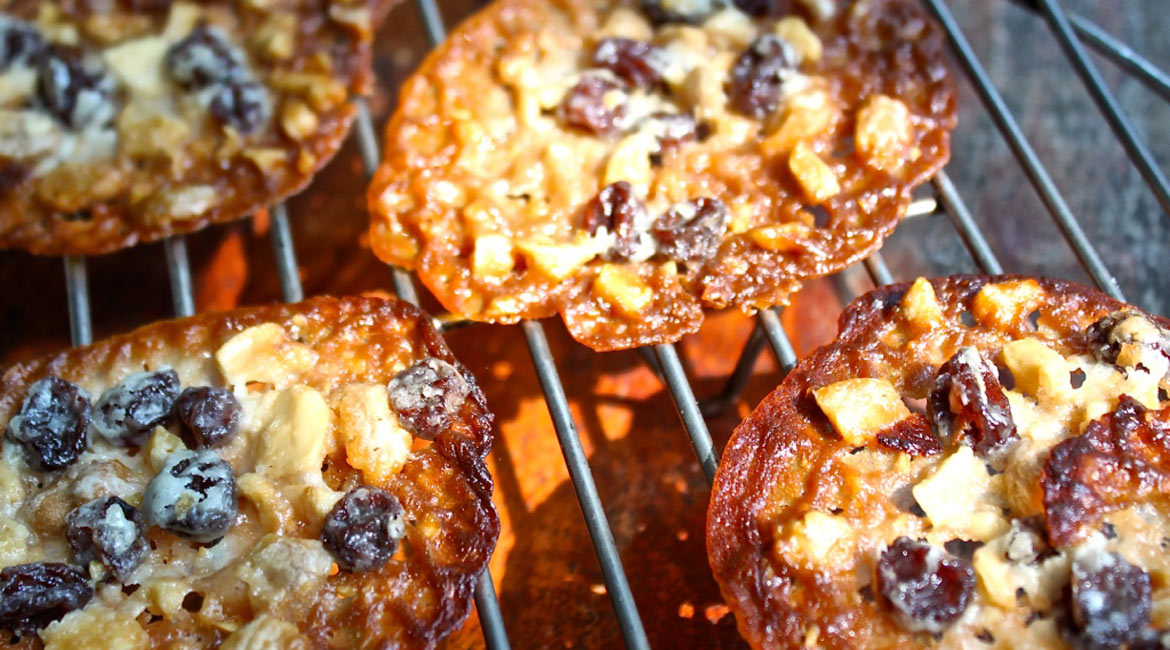The first florentine I ever made was at my English cookery school back in the early 1980s. Flying out of an African civil war, where luxury foods were mostly nonexistent, into the cosseted university town of Oxford, I’d never eaten a biscuit so delicate. Or more-ish. With hindsight, I’ve no doubt florentines played a part in transforming my youthful hourglass figure into the half-hour on the top, three hours on the bottom, wonky egg timer with which I returned home a year later.
That was over 30 years ago, and I’ve hardly made them again since. At least not until I came here and thought about baking them using Mongongo nuts, harvested from the tree that umbrellas our house. Where the idea came from is a mystery. Where it ended up had an adverse effect on the egg timer …

The origin of the florentine is controversial. Wikipedia claims they are Italian, and one would assume they were invented in Tuscany with a name like florentine, but they are, in fact, French. According to a blog post in Honest Cooking called The Truth about Florentines, you just have to look at the main ingredient list to work this one out: butter, cream, sugar, chocolate. “Not only are the main ingredients typically French, but the fact that the base for Florentine biscuits is essentially a roux, an oh-so-French cooking technique, should also signal the true origins of this delicate tea-time cookie.”
Tuscany gave us rustic biscotti, not these Marie Antoinette, lacy, apres-moi-le-crunch.

When florentines work the way they are meant to, they’re a cinch. But herein lies the rub: they are notoriously hit and miss. There are many baking aficionados out there who insist you do this and you do that, but in my experience there are two stages that are critical to creating a wafer-thin crocheted trellis: make sure the base is a consistency that binds all the ingredients, and then keep a close eye on the florentines once they are in the oven.
What goes into a florentine is also up for debate, at least in countries where you have a broad choice of ingredients. Does one use dried fruit or not? What color chocolate is the tastiest? Which nut is best? Traditionally, almonds are used but any (flat-ish) nut works. Here, I have to make do. I use what grows outside, or what we’re storing in the deep freeze.
The classic florentine recipe demands that its bottom be coated with dark chocolate. Mostly, I make “nude” florentines because we like to horde our supply of dark chocolate as and when we receive bars from afar. Nude florentines add a much-needed crunch to a creamy fruit dessert, like a mousse or a fool, and are an impressive treat to serve to guests visiting for afternoon tea.

Mongongo Nut Florentines
Yield: About 25 florentines (the number will depend on their size).
Ingredients:
- 50g/1/2 cup household flour
- 1/4 tsp salt
- 150g/1 cup raisins
- 200g/1 1/2 cup Mongongo nuts, roughly chopped
- 120g/4 oz butter
- 160g/3/4 cup caster sugar
- 50ml cream
Method:
- Preheat the oven to 180/350 degrees, and lightly grease a baking sheet or silplat.
- Sieve the flour and salt into a large bowl, and then mix in the raisins and Mongongo nuts.
- Melt the butter and sugar in a heavy-based saucepan over a low heat until the sugar has dissolved completely.
- Remove from the heat and stir in the cream. Add to the flour mixture and combine well. It will resemble a sticky dough.
- Scoop out the mixture a teaspoon at a time onto the baking sheet, pressing it down into an oval as flat as you can. Be sure to leave ample space between each one because the mixture spreads while cooking.
- Bake in the middle of the preheated oven, about 12-15 minutes. (Keep a close eye on them at this critical stage; they burn easily.)
- Remove and cool, quickly reshaping the florentines into circles if they have spread awkwardly. Transfer to a cooling rack, and repeat the process until you have used up all the mixture.
Note: For those following the classic florentine recipe and coating the bottom with dark chocolate: during the florentines’ cooling process, melt about 150g of dark chocolate in a heatproof bowl over simmering water. Stir occasionally, remove from the heat and cool until the chocolate has thickened a little. Very gently paint the bottom of the florentine with the chocolate. Allow to cool and set.



8 Comments
Oh my, Annabel I was so excited to get another one of your wonderful stories with the recipes! Thank you ! xx
Lovely to hear from you again, Hellie! It’s my pleasure. These can be made with any nut of your preference, and are so light and delicious. xo
Love it…’The classic florentine recipe demands that its bottom be coated with dark chocolate”. We all love to have our bottoms covered in chocolate!
Haha, Pete … you naughty tortoise! Make them … with chocolate! They are soooooo good … xo
Aren’t florentines the best of all cookies? (At least as long as it’s not raining or otherwise too humid.) What do Mongongo nuts taste like?
I think Mongongo nuts taste like a cross between cashews and brazil nuts. They are filled with goodness, which allows me to delude myself that they offset the sugar, butter and cream … haha!
They look delicious!
Sorry for the delay in responding to you, Frank. I have been away from my desk for a few weeks! Thank you for your kind comment. They are indeed delicious! All the best to you … Annabel
Comments are closed.